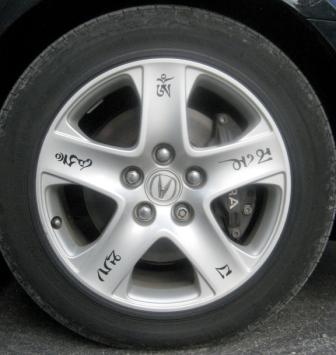Tuesday
Dharma TeachingsMaybe You’d Better Sit Down
By Acharya Michael Greenleaf
Scientists in Germany reported Thursday that the often-described sense of lost-hiker déjà vu, of having inadvertently backtracked while wandering in the woods — is real. “People really do walk in circles,” said Jan L. Souman of the Max Planck Institute for Biological Cybernetics in Tubingen.
— The New York Times, August 2009
The path of meditation shines a light on habitual patterns that keep us lost, both to ourselves and the world we inhabit. For meditation to move forward, however, orientation is essential. As the article from the Times on lost hikers aptly demonstrates, orientation isn’t optional. We always have one. The question is: where is it taking us? Summarized notes and quotes from the Times’ article in bold:
As long as the sun or moon was out, volunteers were able to walk (more or less) in a straight line. But on cloudy days or dark nights, they would loop back on themselves, often several times.
Find a meditation teacher or visit your teacher if you have one. Read a book that speaks to you. Find friends who are interested in meditation. Teachers and companions on the path are the sun and moon that meditators use to orient themselves. They can help you find and adjust your direction. Like any discipline, meditation practice needs view or vision. Teachers and companions on the path of meditation can provide essential guidance.
Information sources in the brain are relative — “they don’t tell you when you are moving in the same direction as an hour ago.” When it comes to being lost — “you cannot trust your own senses at all.” What sets experienced hikers apart? They are “more aware” of what has happened.
The desire to be somewhere else makes it very hard to see where you are and where you’ve been. Looking back on difficult periods in our life, we find that in many ways, our sense of being lost was partly self-imposed and self-perpetuating.
Of course, inasmuch as none of us really know where we are going, being lost is part of the creative process of living. Meditation supports an honest assessment of our situation as human beings. It is practicing acceptance — a first step toward understanding where we are now. Understanding where we are — and have been — is key to changing direction.
“One way to walk straight is to set your sights on a nearby tree, walk to it, find another tree in the same direction, and move to that”. In other words, proceed in steps or stages.
Don’t look for great and immediate staggering results from sitting on your meditation cushion. Set reasonable and thoughtful goals for yourself – and meet them. Authentic meditative traditions have a culture that embody this skillful means. As per Tibet’s greatest yogi/saint Milarepa — “Hasten slowly, and you will soon arrive.”
Without orientation, “little errors will compound themselves” and “when the errors start to build in one direction, the hiker often ends up going around in circles.”
We get frustrated or hurt by life, and then we get upset about being upset. Compounding habits seem to address our pain, but they only perpetuate it. At some point we have to relax and give ourselves a break. Be firm with yourself when you have to be, but there is never a good reason to be harsh or dogmatic. Be your own friend.
There is one sure way to avoid going around in circles:
“Your job as the lost person is to sit down.”
There are unexpected twists and turns to life, and long paths that seem to stretch out in front of us forever. Even so, it is a beautiful journey. When we meet it fully, we discover what it means to be human. Losing our way is an expression of losing a connection with our own heart. Often, even if it doesn’t feel right, we find reasons why we have to keep moving.
Sitting down, paying attention to the sensation of breathing, we can appreciate ourselves, relaxing the habitual patterns that cover our heart and obscure our vision. Looking back on our restlessness, we realize there was a level of frustration, fear or even anger, behind our agitation. When you don’t really know why you’re moving or where you’re heading, find a meditation seat (and space for meditation) where you can be comfortable and sit down!
 __________________________________________
__________________________________________
Editor’s Note: In Tibetan, the word for life as we know it is korwa – which means wheel. A traditional analogy for a live lived without understanding: a bee buzzing around in a jar. At the same time, movement is natural and necessary. And after all, it is possible to hide in stillness as well as activity. In either case, as Michael points out, the question is where are we trying go? For students of meditation, studying a meditation primer for even a few minutes a day can be enormously helpful on the journey.
Acharya Michael Greenleaf lives in West Barnet, Vermont. He is a faculty member of the Mukpo Institute at Karme Choling, a rural meditation center in the Shambhala Buddhist tradition, and a volunteer blogger at Samadhi Cushion’s Blog where this piece first appeared.





